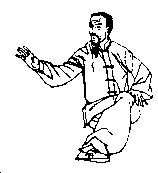Site Map
An art is best learnt in its culture. One remarkable difference between culture of the east and the west is the respect shown to a master. Many eastern masters comment on the lack of respect, sometimes utter disrespect, shown to them. Often it is because of the western students' ignorance of eastern ways rather than their wilful discourtesy that their eastern masters of chi kung or kungfu (including taijiquan) regard as disrespect.
The Chinese characters for Tai Chi Chuan 太極拳 can be translated as the 'Supreme Ultimate Force'. The notion of 'supreme ultimate' is often associated with the Chinese concept of yin-yang, the notion that one can see a dynamic duality (male/female, active/passive, dark/light, forceful/yielding, etc.) in all things. 'Force' (or, more literally, 'fist') can be thought of here as the means or way of achieving this ying-yang, or 'supreme-ultimate' discipline.
Many people are fascinated with the mystical taiji (Tai
Chi) legend of the Taoist
monk, Zhang Sanfeng,
who allegedly invented taijiquan (Tai
Chi Chuan) through dreaming about or observing a fight between a snake
and a crane in Wu-dang Mountains. It's human nature to enjoy and believe
in fairytales. As filmmakers continue to make films with this half-legendary
and half-fictional character, Zhang Sanfeng, based on the stories written
by famous Chinese martial arts novelists such as Jing Yong, I believe
this legend will continue to live for centuries. People always enjoy passing
on this kind of legendary story to future generations like the legends
of King Arthur and Robin Hood.
Known for its slow
tempo and graceful movement, Taijiquan has been mainly practiced as
a moving meditation. Most of the practitioners' unawareness of Taijiquan
being an effective health exercise as well as an in-depth internal martial
arts training can be explained in terms of Taijiquan's evolution and practice.
After years of research and study of historical documents by Taiji practitioners,
it has been proved that most of the major styles of Taiji currently practiced
(e.g., Chen,
Yang,
Sun,
Wu Yuxiang,
Wu Ch'uan-yü
were all derived, directly or indirectly, from Chen Family Taijiquan,
which originated from a small village located in Henan, China, with the
name Chenjiagou, literally, Chen Family Ditch.
"To
approach Nature is to know harmony. To acheive Nature is to be enlightened,
but to surpass Nature invites calamity; for emotion will burst the lungs
and exhaustion will age the heart. The light that burns twice as bright
burns half as long."
![]() Return to Indigenous Peoples' Literature
Return to Indigenous Peoples' Literature
Compiled by: Glenn Welker
ghwelker@gmx.com
This site has been accessed 10,000,000 times since February 8, 1996.




